Hybrid SnO2/TiO2 Nanocomposites for Selective Detection of Ultra-Low Hydrogen Sulfide Concentrations in Complex Backgrounds
Abstract
:1. Introduction
2. Experimental Section
2.1. Fabrication and Characterization of a Suspended Microheater Platform
2.2. Oxides Deposition and Characterization
2.3. Gas Delivery System and Data Acquisition
3. Results and Discussion
Sensor Performance Characteristics
4. Conclusions
Acknowledgments
Author Contributions
Conflicts of Interest
References
- Ou, J.Z.; Ge, W.; Carey, B.; Daeneke, T.; Rotbart, A.; Shan, W.; Wang, Y.; Fu, Z.; Chrimes, A.F.; Wlodarski, W.; et al. Physisorption-Based Charge Transfer in Two-Dimensional SnS2 for Selective and Reversible NO2 Gas Sensing. ACS Nano 2015, 9, 10313–10323. [Google Scholar] [CrossRef] [PubMed]
- Mei, L.; Chen, Y.; Ma, J. Gas Sensing of SnO2 Nanocrystals Revisited: Developing Ultra-Sensitive Sensors for Detecting the H2S Leakage of Biogas. Sci. Rep. 2014, 4, 6028. [Google Scholar] [CrossRef] [PubMed]
- Verma, M.K.; Gupta, V. A highly sensitive SnO2–CuO multilayered sensor structure for detection of H2S gas. Sens. Actuators B Chem. 2012, 166–167, 378–385. [Google Scholar] [CrossRef]
- Wagh, M.S.; Patil, L.A.; Seth, T.; Amalnerkar, D.P. Surface cupricated SnO2–ZnO thick films as a H2S gas sensor. Mater. Chem. Phys. 2004, 84, 228–233. [Google Scholar] [CrossRef]
- Xi, L.; Qian, D.; Tang, X.; Chen, C. High surface area SnO2 nanoparticles: Synthesis and gas sensing properties. Mater. Chem. Phys. 2008, 108, 232–236. [Google Scholar] [CrossRef]
- Hwang, I.-S.; Choi, J.-K.; Kim, S.-J.; Dong, K.-Y.; Kwon, J.-H.; Ju, B.-K.; Lee, J.-H. Enhanced H2S sensing characteristics of SnO2 nanowires functionalized with CuO. Sens. Actuators B Chem. 2009, 142, 105–110. [Google Scholar] [CrossRef]
- Chen, J.; Wang, K.; Hartman, L.; Zhou, W. H2S Detection by Vertically Aligned CuO Nanowire Array Sensors. J. Phys. Chem. C 2008, 112, 16017–16021. [Google Scholar] [CrossRef]
- Kaneti, Y.V.; Yueb, J.; Moriceauc, J.; Chena, C.; Liud, M.; Yuana, Y.; Jiangd, X.; Yua, A. Experimental and theoretical studies on noble metal decorated tin oxide flower-like nanorods with high ethanol sensing performance. Sens. Actuators B Chem. 2015, 219, 83–93. [Google Scholar] [CrossRef]
- Tang, Y.; Su, B.; Liu, M.; Feng, Y.; Jiang, X.; Jiang, L.; Yu, A. Superwettability Strategy: 1D Assembly of Binary Nanoparticles as Gas Sensors. Small 2016. [Google Scholar] [CrossRef] [PubMed]
- Yue, J.; Jiang, X.; Yu, A. Adsorption of the OH Group on SnO2 (110) Oxygen Bridges: A Molecular Dynamics and Density Functional Theory Study. J. Phys. Chem. C 2013, 117, 9962–9969. [Google Scholar] [CrossRef]
- Huang, J.; Wan, Q. Gas Sensors Based on Semiconducting Metal Oxide One-Dimensional Nanostructures. Sensors 2009, 9, 9903–9924. [Google Scholar] [CrossRef] [PubMed]
- Das, S.; Jayaraman, V. SnO2: A comprehensive review on structures and gas sensors. Prog. Mater. Sci. 2014, 66, 112–255. [Google Scholar] [CrossRef]
- Naik, A.; Parkin, I.; Binions, R. Gas Sensing Studies of an n-n Hetero-Junction Array Based on SnO2 and ZnO Composites. Chemosensors 2016, 4, 3. [Google Scholar] [CrossRef]
- Yamazoe, N.; Tamaki, J.; Miura, N. Role of hetero-junctions in oxide semiconductor gas sensors. Mater. Sci. Eng. B 1996, 41, 178–181. [Google Scholar] [CrossRef]
- Costello, L.; Ewen, R.J.; Ratcliffe, N.M.; Sivanand, P. Thick film organic vapour sensors based on binary mixtures of metal oxides. Sens. Actuators B Chem. 2003, 92, 159–166. [Google Scholar] [CrossRef]
- Yamazoe, N.; Shimanoe, K. Proposal of contact potential promoted oxide semiconductor gas sensor. Sens. Actuators B Chem. 2013, 187, 162–167. [Google Scholar] [CrossRef]
- Halek, P.; Teterycz, H.; Halek, G.; Suchorska, P.; Wiśniewski, K. Sensing performance of heterojunction gas sensors based on SnO2, WO3 and ZnO metal oxides. In Proceedings of the IMCS 2012—The 14th International Meeting on Chemical Sensors, Nuremberg, Germany, 20–23 May 2012; Volume 1297–1300.
- Suchorska-Woźniak, P.; Rac, O.; Fiedot, M.; Teterycz, H. Analysis of SnO2|WO3 Heterocontact Properties during the Detection of Hydrogen Sulphide. Sensors 2014, 14, 20480–20499. [Google Scholar] [CrossRef] [PubMed]
- Wager, J.F. Transparent electronics: Schottky barrier and heterojunction considerations. Thin Solid Films 2008, 516, 1755–1764. [Google Scholar] [CrossRef]
- Jiao, Z.; Wang, S.; Bian, L.; Liu, J. Stability of SnO2/Fe2O3 multilayer thin film gas sensor. Mater. Res. 2000, 35, 741–745. [Google Scholar] [CrossRef]
- Guo, W.; Mei, L.; Wenc, J.; Ma, J. High-response H2S sensor based on ZnO/SnO2 heterogeneous nanospheres. RSC Adv. 2016, 6, 15048. [Google Scholar] [CrossRef]
- Huang, W.-F.; Chen, H.-T.; Lin, M.C. Density Functional Theory Study of the Adsorption and Reaction of H2S on TiO2 Rutile (110) and Anatase (101) Surfaces. J. Phys. Chem. C 2009, 113, 20411–20420. [Google Scholar] [CrossRef]
- Chun, S.W.; Jang, J.Y.; Park, D.W.; Woo, H.C.; Chung, J.S. Selective oxidation of H2S to elemental sulfur over TiO2/SiO2 catalysts. Appl. Catal. B 1998, 6, 235–243. [Google Scholar] [CrossRef]
- Garcia, A.; Yan, N.; Vincent, A.; Singh, A.; Hill, J.M.; Chuang, K.T.; Luo, J.-L. Highly cost-effective and sulfur/coking resistant VOx-grafted TiO2 nanoparticles as an efficient anode catalyst for direct conversion of dry sour methane in solid oxide fuel cells. J. Mater. Chem. A 2015, 3, 23973–23980. [Google Scholar] [CrossRef]
- Zhang, X.; Tang, Y.; Qu, S.; Da, J.; Hao, Z. H2S-Selective Catalytic Oxidation: Catalysts and Processes. ACS Catal. 2015, 5, 1053–1067. [Google Scholar] [CrossRef]
- Radecka, M.; Zakrzewska, K.; Rękas, M. SnO2–TiO2 solid solutions for gas sensors. Sens. Actuators B Chem. 1998, 47, 194–204. [Google Scholar] [CrossRef]
- Patil, L.A.; Patil, D.R. Heterocontact type CuO-modified SnO2 sensor for the detection of a ppm level H2S gas at room temperature. Sens. Actuators B Chem. 2006, 120, 316–323. [Google Scholar] [CrossRef]
- Vasiliev, R.B.; Rumyantsev, M.N.; Yakovlev, N.V.; Gaskov, A.M. CuO/SnO2 thin film heterostructures as chemical sensors to H2S. Sens. Actuators B Chem. 1998, 50, 186–193. [Google Scholar] [CrossRef]
- Chowdhuri, A.; Singh, S.K.; Sreenivas, K.; Gupta, V. Contribution of adsorbed oxygen and interfacial space charge for enhanced response of SnO2 sensors having CuO catalyst for H2S gas. Sens. Actuators B Chem. 2010, 145, 155–166. [Google Scholar] [CrossRef]
- Ma, J.; Liu, Y.; Zhang, H.; Ai, P.; Gong, N.; Wu, Y.; Yu, D. Room temperature ppb level H2S detection of a single Sb-doped SnO2 nanoribbon device. Sens. Actuators B Chem. 2015, 216, 72–79. [Google Scholar] [CrossRef]
- Yoo, K.S.; Han, S.D.; Moon, H.G.; Yoon, S.-J.; Kang, C.-Y. Highly Sensitive H2S Sensor Based on the Metal-Catalyzed SnO2 Nanocolumns Fabricated by Glancing Angle Deposition. Sensors 2015, 15, 15468–15477. [Google Scholar] [CrossRef] [PubMed]
- Yang, T.; Yang, Q.; Xiao, Y.; Sun, P.; Wang, Z.; Gao, Y.; Ma, J.; Sun, Y.; Lu, G. A pulse-driven sensor based on ordered mesoporous Ag2O/SnO2 with improved H2S-sensing performance. Sens. Actuators B Chem. 2016, 228, 529–538. [Google Scholar] [CrossRef]
- Liua, H.; Gonga, S.P.; Hua, Y.X.; Liua, J.Q.; Zhoua, D.X. Properties and mechanism study of SnO2 nanocrystals for H2S thick-film sensors. Sens. Actuators B Chem. 2009, 140, 190–195. [Google Scholar] [CrossRef]
- Pedhekar, R.B.; Raghuwanshi, F.C.; Kapse, V.D.; Raisoni, G.H. Low Temperature H2S Gas Sensor Based on Fe2O3 Modified ZnO-TiO2 Thick Film. Int. J. Mater. Sci. Eng. 2015, 3, 219. [Google Scholar] [CrossRef]
- Vaishampayan, M.V.; Deshmukh, R.G.; Walke, P.; Mulla, I.S. Fe-doped SnO2 nanomaterial: A low temperature hydrogen sulfide gas sensor. Mater. Chem. Phys. 2008, 109, 230–234. [Google Scholar] [CrossRef]
- Fang, G.; Liu, Z.; Liu, C.; Yao, K. Room temperature H2S sensing properties and mechanism of CeO2–SnO2 sol–gel thin films. Sens. Actuators B Chem. 2000, 66, 46–48. [Google Scholar] [CrossRef]
- Liu, H.; Wu, S.; Gong, S.; Zhao, J.; Liu, J.; Zhou, D. Nanocrystalline In2O3–SnO2 thick films for low-temperature hydrogen sulfide detection. Ceram. Int. 2011, 37, 1889–1894. [Google Scholar] [CrossRef]
- Fu, D.; Zhu, C.; Zhang, X.; Lia, C.; Chen, Y. Two-dimensional net-like SnO2/ZnO heteronanostructures for high-performance H2S gas sensor. J. Mater. Chem. A 2016, 4, 1390. [Google Scholar] [CrossRef]
- Tang, H.; Prasad, K.; Sanjinès, R.; Schmid, P.E.; Lévy, F. Electrical and optical properties of TiO2 anatase thin films. J. Appl. Phys. 1994, 75, 2042. [Google Scholar] [CrossRef]
- Floriano, E.A.; Scalvi, L.V.A.; Saeki, M.J.; Sambrano, J.R. Preparation of TiO2/SnO2 Thin Films by Sol−Gel Method and Periodic B3LYP Simulations. J. Phys. Chem. A 2014, 118, 5857–5865. [Google Scholar]
- Trakhtenberg, L.I.; Gerasimov, G.N.; Gromov, V.F.; Belysheva, T.V.; Ilegbusi, O.J. Gas Semiconducting Sensors Based on Metal Oxide Nanocomposites. J. Mater. Sci. Res. 2012, 1, 56–68. [Google Scholar] [CrossRef]
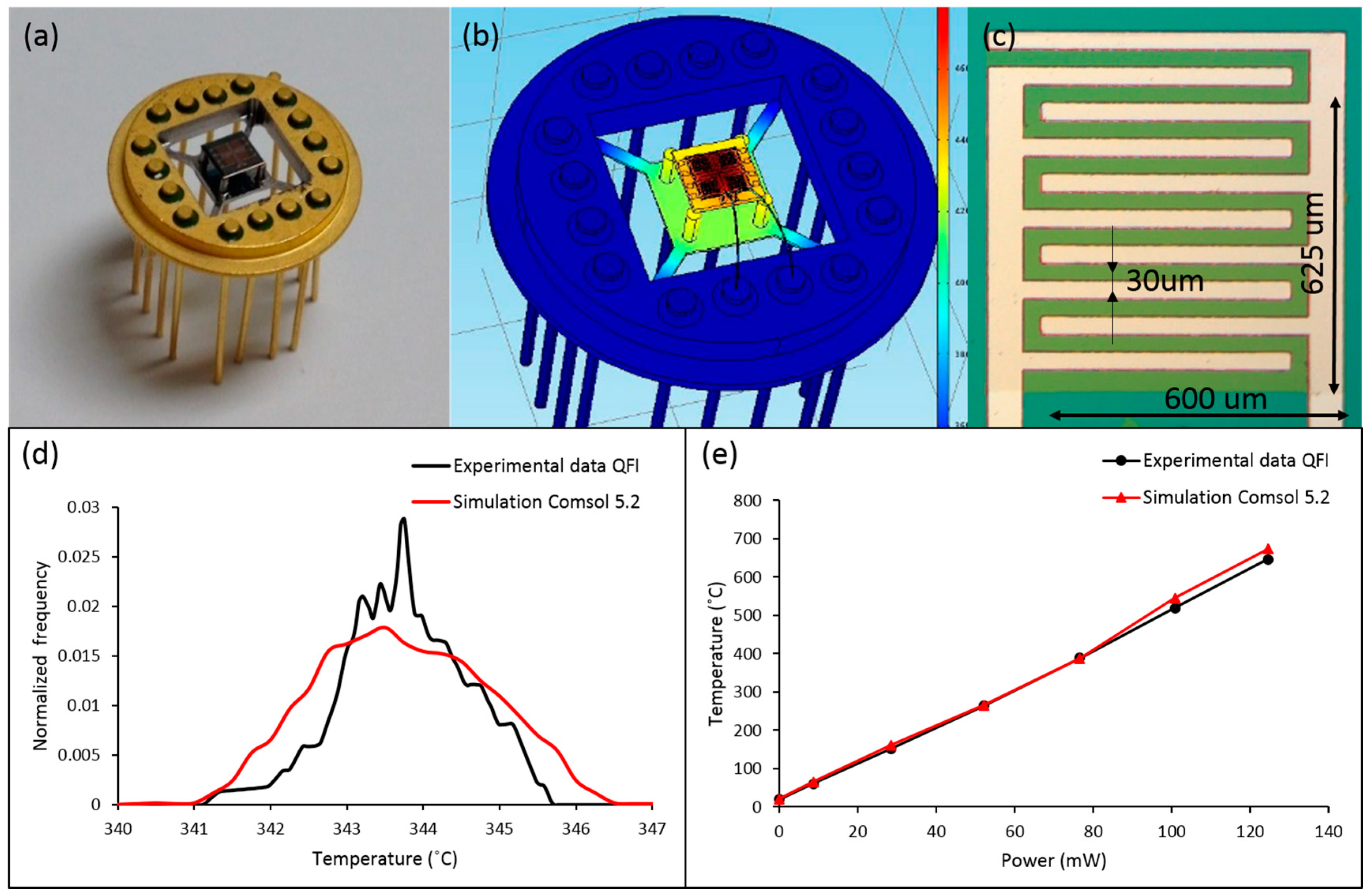

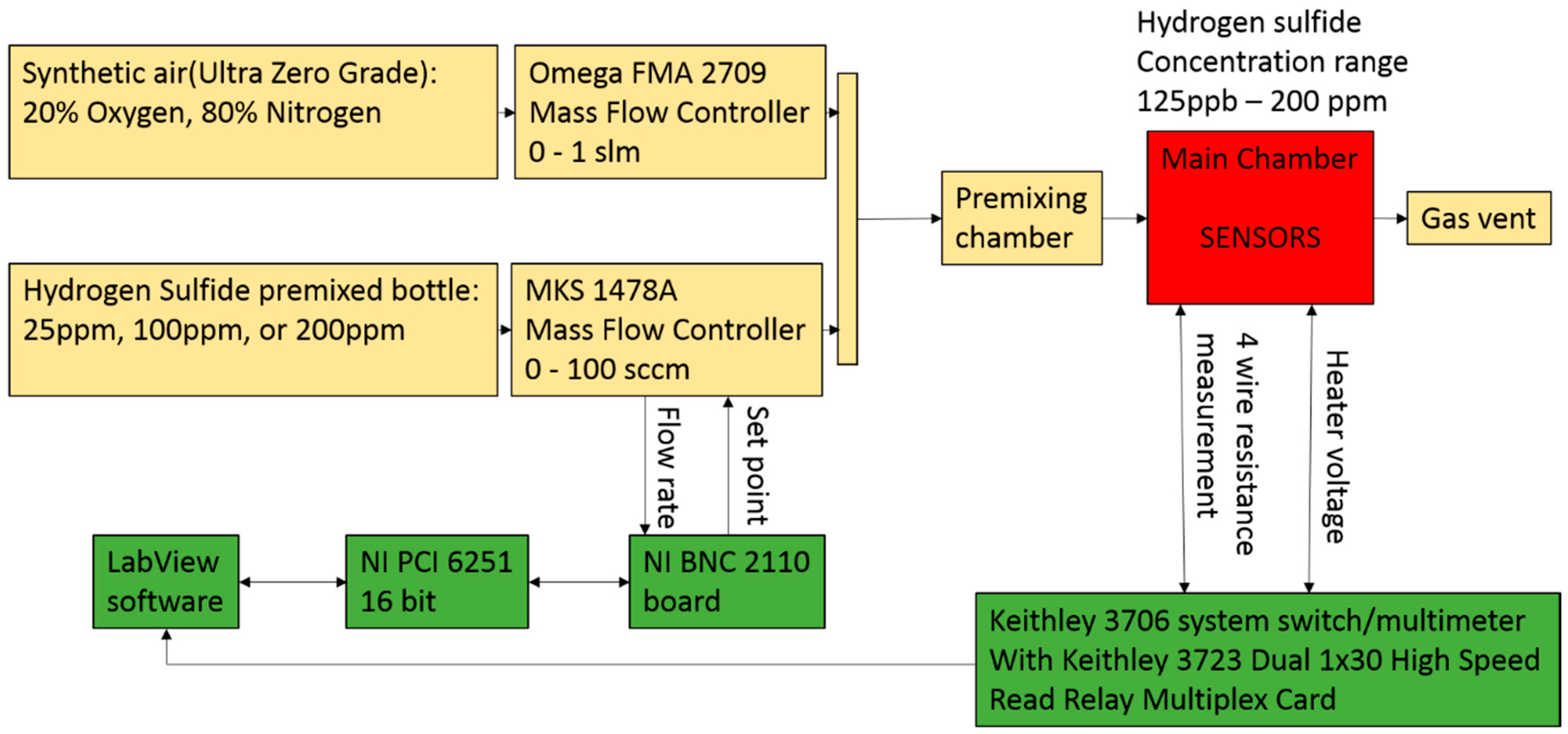

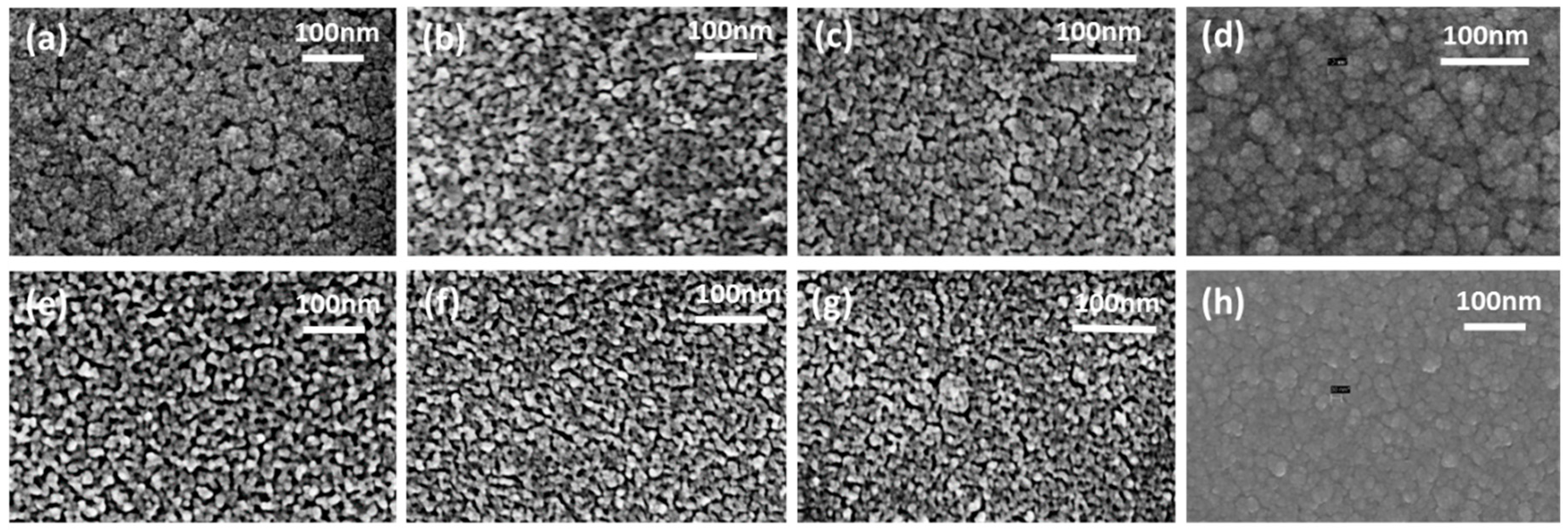



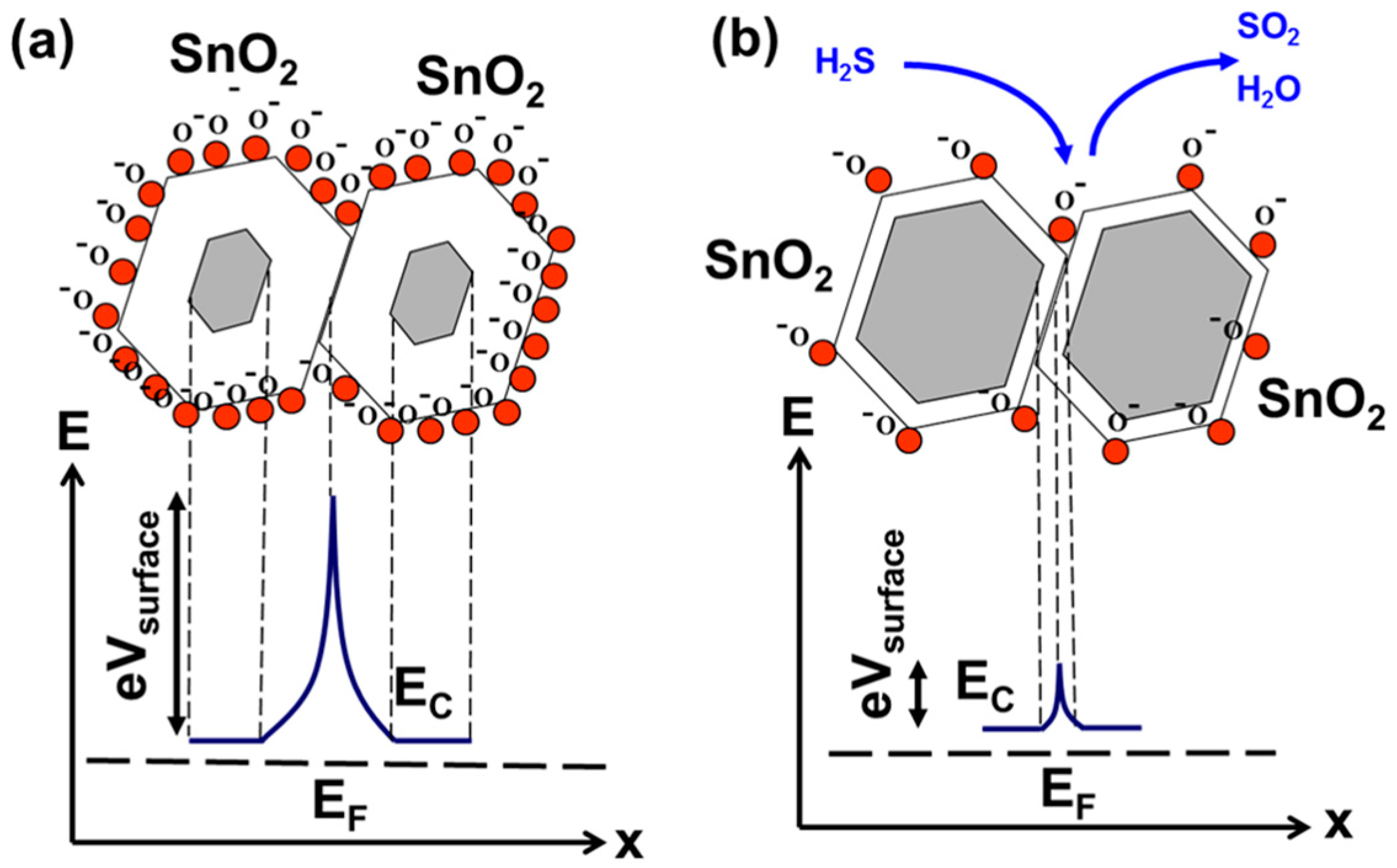
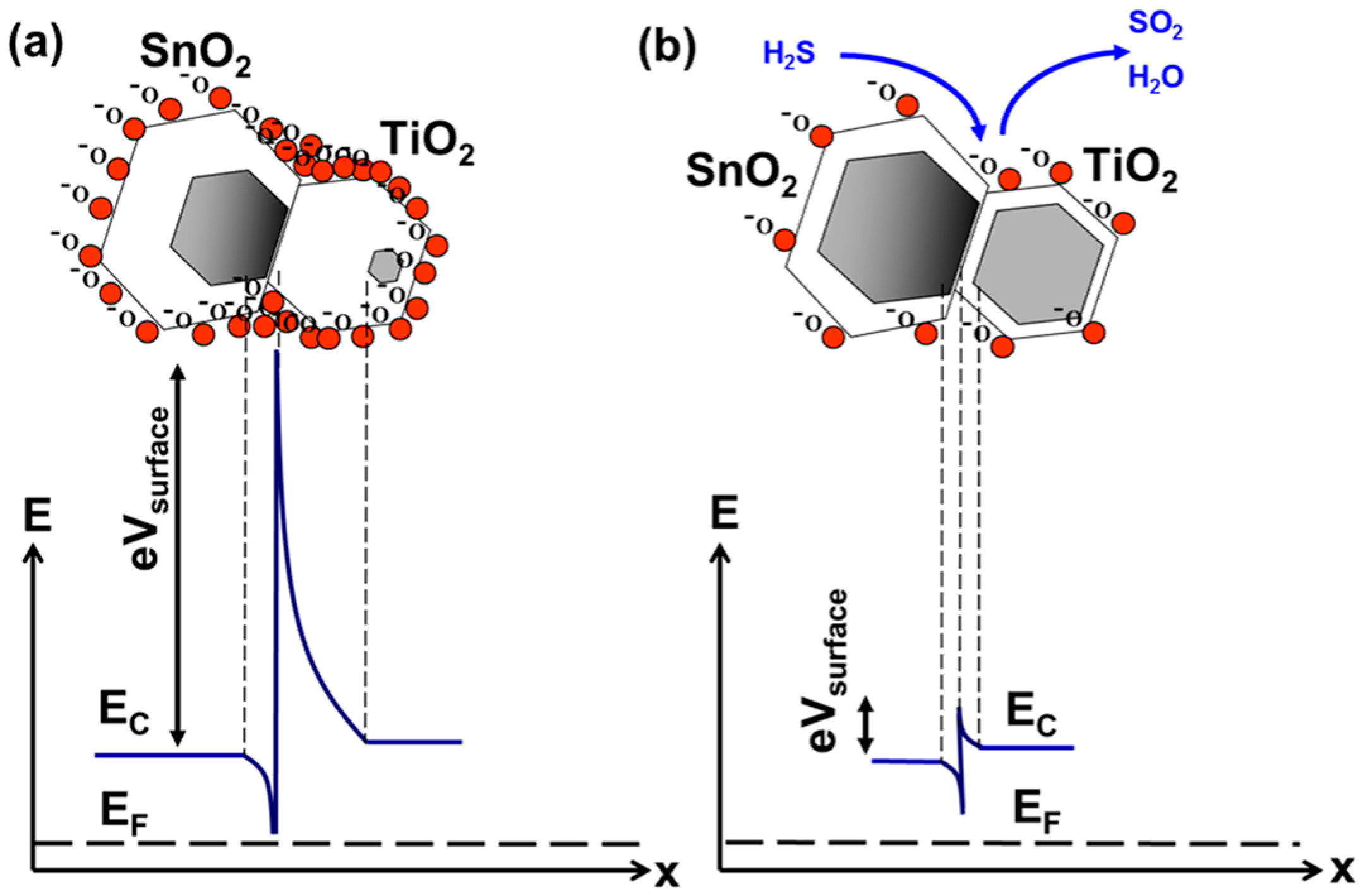
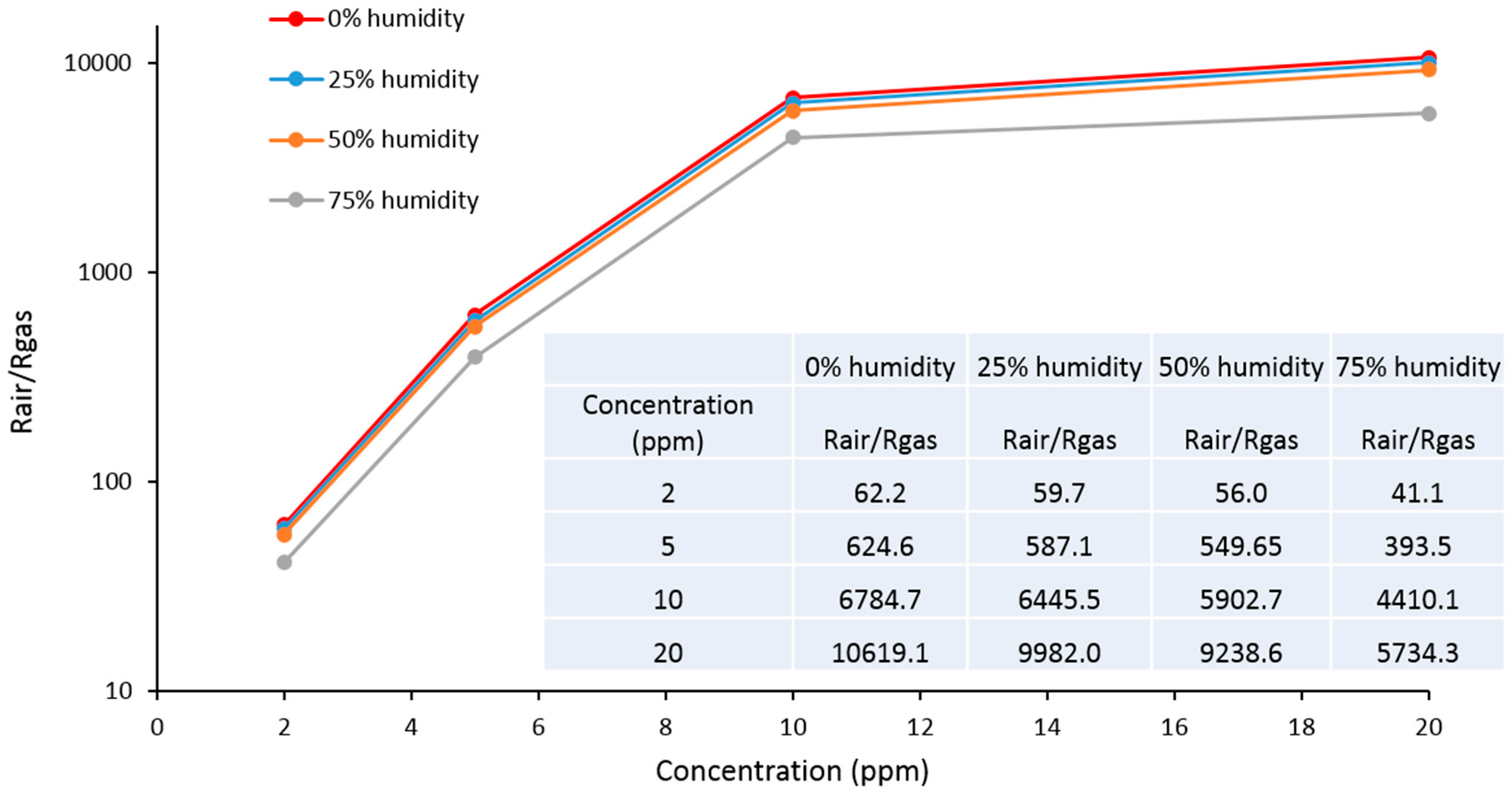
| Material and Structure | Deposition Technique | Concentration (ppm) | Sensitivity (Ra/Rg) | Temperature (°C) | Reference |
|---|---|---|---|---|---|
| SnO2 porous thick film | Sol gel method | 30 | 30 | 150 | [30] |
| Sb-SnO2 nanoribbons | Thermal evaporation | 0.1 | 10 | 150 | [27] |
| Ag-SnO2 nanocolumns | Glacncing Angle Deposition | 5 | 66 | 300 | [28] |
| Au-SnO2 nanocolumns | Glacncing Angle Deposition | 5 | 111 | 300 | [28] |
| Ag2O-SnO2 mesoporous | Nanocasting | 0.3 | 5.7 | 100 | [29] |
| Fe-SnO2 nanoparticles | Pechini method | 200 | 100 | 25 | [32] |
| TiO2/SnO2/Fe2O3 thick film | Hydrothermal method | 285 | 46 | 40 | [31] |
| CeO2–SnO2 thin film | Sol gel method | 50 | 23 | 25 | [33] |
| In2O3-SnO2 thick film | Screen printing | 100 | 1.4 × 103 | 25 | [34] |
| SnO2-ZnO 2D heteronanostructures | Sputtering | 0.01 | 5 | 100 | [35] |
| CuO-SnO2 thin film | Magnetron sputtering | 100 | 1.6 × 104 | 170 | [25] |
| CuO–SnO2 thick film | Screen printing | 1 | 8 × 103 | 50 | [24] |
| CuO-SnO2 bilayer heterostructure | Reactive sputtering | 20 | 7.4 × 103 | 150 | [26] |
| Sensing Material | Composition | Total Thickness | Sample Number |
|---|---|---|---|
| SnO2 | 100% | 30 nm | S0 |
| SnO2/TiO2 bilayer | 30 nm + 5 nm | 35 nm | S1 |
| SnO2/TiO2 bilayer | 30 nm + 8 nm | 38 nm | S2 |
| SnO2/TiO2 bilayer | 30 nm + 20 nm | 50 nm | S3 |
| SnO2/TiO2 multilayer | 5% TiO2 | 31.5 nm | S4 |
| SnO2/TiO2 multilayer | 10% TiO2 | 33 nm | S5 |
| SnO2/TiO2 multilayer | 20% TiO2 | 36 nm | S6 |
| TiO2 | 100% | 30 nm | S7 |
| Sample | R Air (Ω) | R Gas (Ω) | R Air/R Gas | Temperature (°C) |
|---|---|---|---|---|
| S0 | 1.10 × 106 | 8.43 × 103 | 1.31 × 102 | 225 |
| S1 | 2.53 × 107 | 2.64 × 104 | 9.55 × 102 | 200 |
| S2 | 2.50 × 108 | 1.85 × 105 | 1.88 × 103 | 200 |
| S3 | 8.93 × 104 | 1.17 × 103 | 7.60 × 101 | 250 |
| S4 | 6.90 × 106 | 6.99 × 102 | 9.87 × 103 | 150 |
| S5 | 9.39 × 106 | 8.82 × 102 | 1.06 × 104 | 150 |
| S6 | 3.21 × 105 | 6.65 × 102 | 4.83 × 102 | 150 |
| Sample Number | Response Time T90 (s) | Recovery Time T90 (s) | Concentration (ppm) | Temperature (°C) |
|---|---|---|---|---|
| S0 | 3.7 | 5.6 | 10 | 225 |
| S1 | 3.5 | 2.8 | 10 | 200 |
| S2 | 3.3 | 2.5 | 10 | 200 |
| S3 | 3.7 | 2.9 | 10 | 250 |
| S4 | 3.0 | 2.4 | 10 | 150 |
| S5 | 3.2 | 2.4 | 10 | 150 |
| S6 | 3.9 | 2.7 | 10 | 150 |
© 2016 by the authors; licensee MDPI, Basel, Switzerland. This article is an open access article distributed under the terms and conditions of the Creative Commons Attribution (CC-BY) license (http://creativecommons.org/licenses/by/4.0/).
Share and Cite
Larin, A.; Womble, P.C.; Dobrokhotov, V. Hybrid SnO2/TiO2 Nanocomposites for Selective Detection of Ultra-Low Hydrogen Sulfide Concentrations in Complex Backgrounds. Sensors 2016, 16, 1373. https://doi.org/10.3390/s16091373
Larin A, Womble PC, Dobrokhotov V. Hybrid SnO2/TiO2 Nanocomposites for Selective Detection of Ultra-Low Hydrogen Sulfide Concentrations in Complex Backgrounds. Sensors. 2016; 16(9):1373. https://doi.org/10.3390/s16091373
Chicago/Turabian StyleLarin, Alexander, Phillip C. Womble, and Vladimir Dobrokhotov. 2016. "Hybrid SnO2/TiO2 Nanocomposites for Selective Detection of Ultra-Low Hydrogen Sulfide Concentrations in Complex Backgrounds" Sensors 16, no. 9: 1373. https://doi.org/10.3390/s16091373





